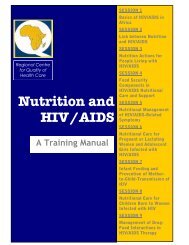2.1: Anthropometric Indicators Measurement Guide - Linkages Project
2.1: Anthropometric Indicators Measurement Guide - Linkages Project
2.1: Anthropometric Indicators Measurement Guide - Linkages Project
Create successful ePaper yourself
Turn your PDF publications into a flip-book with our unique Google optimized e-Paper software.
9.<br />
Analysis<br />
Once all the children have been measured<br />
by all the measurer-pairs, the supervisor<br />
should meet with the group to analyze the<br />
results of the exercise and the measurers<br />
read out-loud the results of his/her<br />
measurements for each child. The<br />
measurers should record these results in<br />
their respective forms, under the<br />
STANDARD MEASURE column (see<br />
Forms 1 and 2). Next, each of the<br />
measurers should calculate the difference<br />
between MY MEASURE and STANDARD<br />
MEASURE for each measurement and<br />
child, and record the result on the same<br />
form under the DIFFERENCE column,<br />
using the corresponding + or - sign: if the<br />
measurer’s measurement is larger than<br />
the supervisor’s measurement (standard<br />
measurement), the sign is positive; if the<br />
measurer’s measurement is lower than<br />
the supervisor’s measurement, the sign is<br />
negative. Following this procedure, the<br />
measurers should draw a circle to the<br />
right of the large and medium differences<br />
as follows:<br />
<strong>Measurement</strong> Whole Circle No Circle<br />
Empty Circle<br />
Child’s weight 0.2 kg < 0.2 kg<br />
0.3 kg or more<br />
Child’s length 0.6 to 0.9 cm < 0.6 cm<br />
/height 1.0 cm<br />
or more<br />
Each measurer then totals the number of<br />
large differences (marked with a whole<br />
circle) and the number of medium<br />
differences (marked with an empty circle),<br />
and records the totals in the corresponding<br />
boxes on the lower part of the form (box 1<br />
for large differences and box 2 for medium<br />
differences). The sum of all small<br />
differences or no differences should be<br />
calculated and recorded in box 3.<br />
Finally, the difference between the<br />
number of positive and negative differences<br />
(excluding zeros) should be calculated and<br />
recorded in the big box on the form with its<br />
corresponding sign. For example, if there<br />
are 6 positive differences, 3 negative<br />
differences, and a zero, the result is +3; if<br />
there are 8 negative differences and 2<br />
positive differences, the result is -6.<br />
Interpretation<br />
The interpretation of the standardization<br />
exercise results is made by the measurers<br />
with the supervisor’s help. The purpose is<br />
to detect differences, identify their<br />
possible causes, and correct them. To<br />
achieve this, it is important to take into<br />
account the size of the differences<br />
between each measurer and the<br />
supervisor, as well as the positive or<br />
negative sign of the differences.<br />
1. Size of the differences<br />
The total number of the differences,<br />
according to their size, has already been<br />
recorded by line 1, 2, and 3 located in at<br />
the bottom of the form, as follows: large<br />
differences in line 1, medium ones in line<br />
2, and small differences (including the<br />
absence of differences) in line 3. As the<br />
number of differences in lines 1 and 2<br />
decreases, especially in line 1, the<br />
agreement between the measurer and the<br />
supervisor increases; that is, the better the<br />
standardization of the measurer with the<br />
supervisor. Large differences (line 1)<br />
generally indicate carelessness in the<br />
reading or recording, or serious problems<br />
in the measurement technique. Moderate<br />
differences usually indicate problems in<br />
the measurement technique. The ideal is<br />
to obtain the largest number in line 3,<br />
(small differences or complete<br />
agreement).<br />
In cases where large or medium<br />
differences are found, the respective<br />
measurer with the assistance of the<br />
supervisor should carefully repeat the<br />
measurement in order to identify and<br />
correct the cause of the differences.<br />
2. Sign of the differences<br />
If the total registered in the big box is +6<br />
or more, the measurer’s measurements<br />
are consistently larger than the<br />
supervisor’s. For weight measurements,<br />
the most frequent causes for differences<br />
are: not adjusting the scale to zero at the<br />
beginning; reading the scale in an oblique<br />
position and not facing the scale; or<br />
reading the scale by following the<br />
90

















